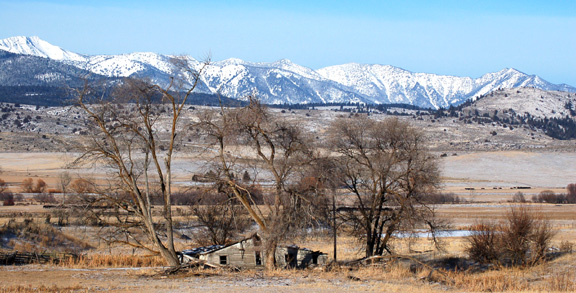In a recent editorial from the Baker City Herald Editorial Board (A Little Bit Fishy: http://www.bakercityherald.com/Editorials/A-little-bit-fishy), they complain that "the government risks its credibility when it claims a species is in peril yet can’t answer questions about the species that the public should, and probably will, ask."
I strongly disagree, because the government, has is fact answered the public's questions and provided a good deal of explanatory material in the proposed and final rules from 2002 to 2010. They can't, of course, be held responsible for the public's or the Heralds lack of knowledge concerning the principles of conservation biology and "connectivity," or for not answering questions that haven't been asked.
Bull Trout
 Fish & Wildlife Service Photo
Fish & Wildlife Service PhotoThe board has printed many editorials that I agree with, especially those that deal with a fiscally conservative approach to spending the people's money (but not their recommendation of a "no" vote on measures 66 & 67), but we come to those conclusions it seems from different perspectives. The main difference to me seems to be that they want to preserve the current system of inappropriate distribution of the country's wealth, including its native flora and fauna, while I would like to change it.
I understand that in a county as "conservative" as Baker County, that a media outlet will tend to sit on the fence or take editorial positions in accordance with the political views of the majority of their readers, which include, among other things, fiscal conservatism, and unfortunately for the biosphere, an animosity toward environmental reforms intended to save the habitats and species that were here before our self-centered and destructive appearance on the historic landscape.
In their editorial, in addition to suggesting that the government "can’t answer questions about the species that the public should, and probably will, ask" they write "of 251 miles of the Powder River and its tributaries proposed as critical habitat, almost one-third — 76 miles —harbor not a single bull trout, according to the FWS." They are of course speaking of habitat that was historically used by bull trout before we altered and nearly destroyed its usefulness to bull trout because of the changes accompanying agricultural development, grazing, mining, logging, and roading activities.
They continue by explaining that "Now we understand that in some cases it’s defensible to protect habitat for a species even when there’s no evidence that species lives there. Terrestrial animals can cover a lot of ground, after all. . . . there are thousands of acres of suitable habitat for lynx on the forest, and it’s reasonable for the forest to try to preserve that habitat because lynx could return. . . . Fish, of course, are considerably more restricted in their movements." These last few statements seem to suggest that the Herald thinks while it may be "reasonable" to protect vacant habitat for terrestrial animals, fish are different because they lack the mobility of land-bound animals, and are restricted to aquatic habitat. The logic of such a notion escapes me given that the principles of conservation biology apply regardless of type of habitat or differences in modes of mobility.
Their greatest concern seems to be that "federal officials say it’s necessary to designate as critical habitat streams where bull trout are absent because those streams are connected to ones where bull trout do live. . . . . That sounds all right in theory. Except the FWS report fails to explain why the isolated bull trout populations in the Powder River system aren’t connecting, as it were, to the streams that have suitable habitat."
I am not a fast friend of the Fish and Wildlife Service or other Federal agencies, and have criticized their perceived failures many times, but a even a cursory look at the Bull Trout listing documents produced over the years reveals that the Herald is mistaken. The agencies have explained and answered these question and more.
Connectivity in the science established by the discipline of conservation biology, consists, in its simplest sense, of the existence of suitable corridors, terrestrial (over land) or aquatic (i.e., streams, lakes, and rivers), to allow for the natural migration of a species. For bull trout, aquatic corridors allow their migration between spawning and rearing habitat in cold, clean upstream waters to and through foraging (feeding), migratory, and overwintering habitat downstream. Much of this downstream habitat has been blocked or degraded to the point that it is no longer useful. In coastal regions, bull trout, if unimpeded by various obstructions, even migrate into salt water ocean harbors for a portion of their lives as juveniles.
A reading of all the recovery plan documents suggests, despite the Herald's claim, that the government has adequately explained the problem: "Currently, habitat fragmentation and degradation are likely the most limiting factors for bull trout throughout the Hells Canyon Complex Recovery Unit. In the Snake River, large dams of the Hells Canyon Complex lack fish passage and have isolated bull trout among three basins, the Pine Creek and Indian Creek watersheds, Wildhorse River, and Powder River. Dams, irrigation diversions, and road crossings have formed impassable barriers to fish movement within the basins, further fragmenting habitats and isolating bull trout. Land management activities that degrade aquatic and riparian habitats by altering stream flows and riparian vegetation, such as water diversions, past and current mining operations, timber harvest and road construction, and improper grazing practices, have negatively affected bull trout in several areas of the recovery unit." ( 2002 Recovery Plan, Ch. 13, p. 4)
Improper Grazing Practices Degrade Water Quality
 Degraded Water Quality from Trampled Streambanks Interferes With Fish Reproduction
Degraded Water Quality from Trampled Streambanks Interferes With Fish ReproductionAlso, in the Introduction (Ibid, pp. 4 &5): "Declines in bull trout distribution and abundance are the results of combined effects of the following: habitat degradation and fragmentation, the blockage of migratory corridors, poor water quality, angler harvest and poaching, entrainment (process by which aquatic organisms are pulled through a diversion structure or other device) into diversion [irrigation] channels and dams, and introduced nonnative species. Specific land and water management activities that continue to depress bull trout populations and degrade habitat include dams and other diversion structures, forest management practices, livestock grazing, agriculture, road construction and maintenance, mining, and urban and rural development. Some threats to bull trout are the continuing effects of past land management activities."
Further, in the 2004 "Final Rule," (http://frwebgate.access.gpo.gov/cgi-bin/getdoc.cgi?dbname=2004_register&docid=fr06oc04-25), the Fish and Wildlife Service explains that:
"The ability to migrate is important to the persistence of local bull trout subpopulations (Rieman and McIntyre 1993; Gilpin 1997; Rieman and Clayton 1997; Rieman et al. 1997). Bull trout rely on migratory corridors to move from spawning and rearing habitats to foraging and overwintering habitats and back. Migratory bull trout become much larger than resident fish in the more productive waters of larger streams and lakes, leading to increased reproductive potential (McPhail and Baxter 1996). Also, local populations that have been extirpated by catastrophic events may become reestablished as a result of movements by bull trout through migratory corridors (Rieman and McIntyre 1993; MBTSG 1998). Activities that preclude the function of migratory corridors may affect bull trout (e.g., stream blockages)." (p. 60025)
Whether the migratory habitat is currently occupied, in the sense that one can always find a fish there, is simply irrelevant. The migratory habitat is necessary for fish to get from one suitable habitat, and isolated population, to another, for purposes that help guarantee the survival of the species.
They explain this further on p. 60024:
"Restoration of reproducing bull trout populations to additional portions of their historical range would significantly reduce the likelihood of extinction due to natural or human-caused factors that might otherwise further reduce population size and distribution. Thus, an integral component of the draft Recovery Plan is the selective reestablishment of secure, self-sustaining populations in certain areas where the species has apparently, but not necessarily conclusively, been extirpated. In this regard, we also note that some habitat areas that would not be considered essential if they were geographically isolated are, in fact, essential to the conservation of the species when situated in locations where they facilitate movement between local populations, or otherwise play a significant role in maintaining recolonize adjacent habitat patches following periodic extirpation events) (Dunham and Rieman 1999). In addition, populations on the periphery of the species' range, or in atypical environments, are important for maintaining the genetic diversity of the species and could prove essential to the ability of the species to adapt to rapidly changing climatic and environmental conditions (Leary et al. 1993; Hard 1995)."
In the Jan. 14, 2010 Proposed Rule (Federal Register / Vol. 75, No. 9 / Thursday, January 14, 2010 / Proposed Rules, p. 2279
http://edocket.access.gpo.gov/2010/pdf/2010-176.pdf), the government states under "Primary Constituent Elements," the need of the bull trout species for:
"(2) Migratory habitats [i.e., connectivity] with minimal physical, biological, or water quality impediments between spawning, rearing, overwintering, and freshwater and marine foraging habitats, including but not limited to permanent, partial, intermittent, or seasonal barriers."
More explanations on the need for connectivity:
Also under "Criteria Used To Identify Critical Habitat," the 2010 Proposed Rule says on p. 2280, in addition to ensuring "sufficient connectivity among populations," that "(4) In selecting areas to propose as critical habitat, we considered factors specific to each river system, such as size (i.e., stream order), gradient, channel morphology, connectivity to other aquatic habitats, and habitat complexity and diversity, as well as range-wide recovery considerations. We took into account the fact that bull trout habitat preference ranges from small headwater streams used largely for spawning and rearing, to downstream mainstem portions of river networks used for rearing, foraging, migration, or overwintering." On p. 2281 they write, "Our primary consideration for most unoccupied areas is restoring connectivity among populations by protecting FMO (foraging, migration, and over-wintering) habitats."
There is an extended discussion of the effects on human activities and the need for connectivity on p. 2282 of this last document, and it is sprinkled with further commentary regarding the need for habitat connectivity throughout. Also included are references to publications documenting their findings in the government documents.
An internet accessible discussion of habitat fragmentation and the need for connectivity can be found at the Craighead Environmental Research Institute (http://www.conservationgis.org/scgis/ScgNews2/ctspsection/ct96craighead.html). They include the following paragraph:
"Habitat reduction and fragmentation at a variety of spatial scales has been widely acknowledged as a primary cause of the decline of many species worldwide (Ehrlich 1986, Lovejoy et al. 1986, Harris 1984). Habitat fragmentation generally leads to smaller and more isolated animal populations. Smaller populations are then more vulnerable to local extinction, due to stochastic [random] events (Shaffer 1978, Gilpin and Soule 1986), and they are more susceptible to the negative effects of inbreeding depression. To reduce the isolation of habitat fragments, many conservation biologists (e.g. Noss 1983, 1987, Noss and Harris 1986, Craighead et al. 1997, Craighead and Vyse 1995, Paetkau et. al. 1997) have recommended maintaining landscape "connectivity" -- preserving habitat for movement of species between remaining fragments."
The "connectivity" they refer to includes aquatic connectivity for the biological and reproductive needs of fish species.
There is much more to the "connectivity" story, including protection from random disasters in isolated habitat, and the need to reestablish a population where it has been eliminated by one transitory problem or another. Connectivity also serves the genetic diversity of local populations by allowing fish from one locale to mingle and breed with another population elsewhere. If anyone is interested in knowing the current science about habitat fragmentation and connectivity, I suggest beginning with the the works of Michael Soule and Reed Noss.
So, we get back to the original Herald editorial. Is it really true, as claimed by the Herald editorial board, that the government "can’t answer questions about the species that the public should, and probably will, ask?" Why does the Baker City Herald spread false doubt and ignorance that only inflames the public against environmentalists and one of the few agencies in government that is doing something, although less than it could or actually should do, to protect threatened species?
A larger question is why have we allowed private and quasi-public commerce, the agricultural and hydropower sectors of the economy, to expropriate the biologically productive riverine systems, and the water and connectivity needed by fish, for their own benefit? Prior to the construction of dams and irrigation diversion structures, salmon, steelhead and bull trout used to migrate to the headwaters of the Powder, Malheur and other watersheds, but the dams and diversions for farm and ranch irrigation, and electricity production, not to mention the trashing of spawning and rearing streams by privately owned cattle on public lands, have denied the people of those public benefits. How is it that those natural resource gifts have been eliminated in our watersheds and driven to the brink of extinction elsewhere, stolen in a sense from the majority of the population, so as to fill the needs of private enterprise?
Bull Trout
 Fish and Wildlife Service Photo
Fish and Wildlife Service Photo












No comments:
Post a Comment